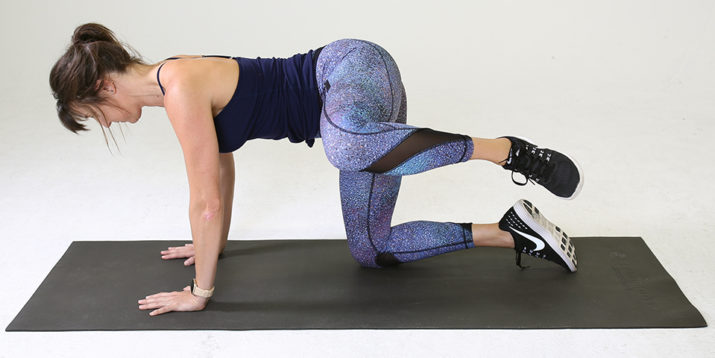Fire Hydrant Exercise: How to Strengthen Your Glutes With This Simple Move

Let’s just get the central premise of this move out of the way, while at the same time conveying its movement pattern: the name for the fire hydrant exercise is derived from its resemblance to the manner in which a dog relieves himself on a water plug, as The Fresh Prince used to call it.
There are some key components to this move, making it effective not only in strengthening and activating your rear, but also in creating mobility throughout your hips.
It also trains you to tighten your core and maintain control of the contraction.
The fire hydrant may seem simple, and if done without attention to detail it can be performed quite easily — and ineffectively.
But if you follow the cues and remain conscious of the muscles you’re targeting, it will definitely increase muscle strength and definition.
Fire Hydrant Exercise: Step-by-Step Instructions

- Start on all fours with your hands under your shoulders and your knees under your hips. This is your starting position.
- Keeping your hips level and your core engaged (see below for more on that), raise your right knee out to the side as high as you can, and hold for 1 second.
- Lower your right leg to return to the starting position, and repeat for a total of 15 reps. Then switch sides and repeat the sequence.
Form check: It’s important to make sure you’re opening your hip throughout the move rather than rotating your torso to elevate your knee. Keep both arms straight, and try not to rock or tilt your hips.
How to Intensify the Fire Hydrant Exercise
- Loop a resistance band around both legs, just above your knees, while performing the move, or wear ankle weights.
- After raising your leg, straighten it directly behind you, knee locked, toes pointed toward the floor, while keeping your core tight. Then return to the starting position.
- As you raise your leg, hold the top position and add a pulse movement by dropping your leg a few inches and then raising it again, repeating the pulse for a total of 3-5 reps before returning your knee to the starting position.
Muscle Groups Used in the Fire Hydrant Exercise
The primary muscle targeted by the fire hydrant exercise is the gluteus medius, as you raise and lower your leg.
Working the medial glutes in this manner better equips you for side-to-side movement, and aids overall stability.
Additionally, the fire hydrant exercise helps strengthen your core because it’s engaged throughout the move.
Since this exercise is often performed without resistance, it’s important to create some on your own. This can be accomplished by learning to tighten your core.
This action helps create stability in your torso, accomplishing two important things: first, giving you significant control over whatever weight you’re attempting to mobilize, and second, protecting your spine from stress and compression.
How to Engage Your Core on All Fours
The fire hydrant exercise is a great way to reinforce core stability, so we’ll further explain the technique by which you should be engaging this muscle group.
- With your hands directly under your shoulders and your knees under your hips, gently contract your glutes (basically, squeeze your butt).
- Tuck your tailbone as if you’re drawing your butt up into your belly button. This will tighten up your lower abdomen and pelvis, flattening them out.
- Exhale sharply to tighten the upper part of your abdomen so your whole core is engaged. Once you’ve created this tension it’s important to practice breathing in this tight, controlled space.
- Finally, pull your shoulders back and down, flattening out your back, and set your gaze just beyond your hands, putting your head in a neutral position. A helpful cue here to stabilize your back is to imagine screwing your hands into the ground, with your arms rotating outward. You aren’t actually moving your hands, just applying that pressure to engage your lats and back.
Fire Away
Your core and hips are your center of gravity, so you want to ensure proper movement, stability, and control by keeping those muscles functional, healthy, and strong. Practicing the fire hydrant exercise with proper form will help you strengthen your core and hips, as well as promote greater control over the associated muscles.

